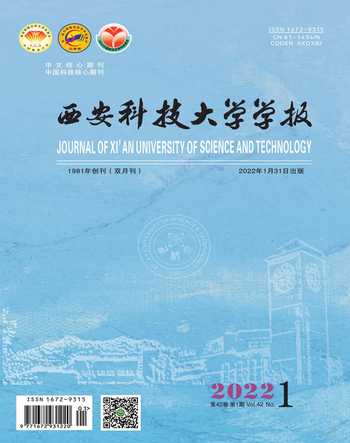风量影响下的煤自燃定量预测预报指标试验研究
王凯 韩涛 和运中
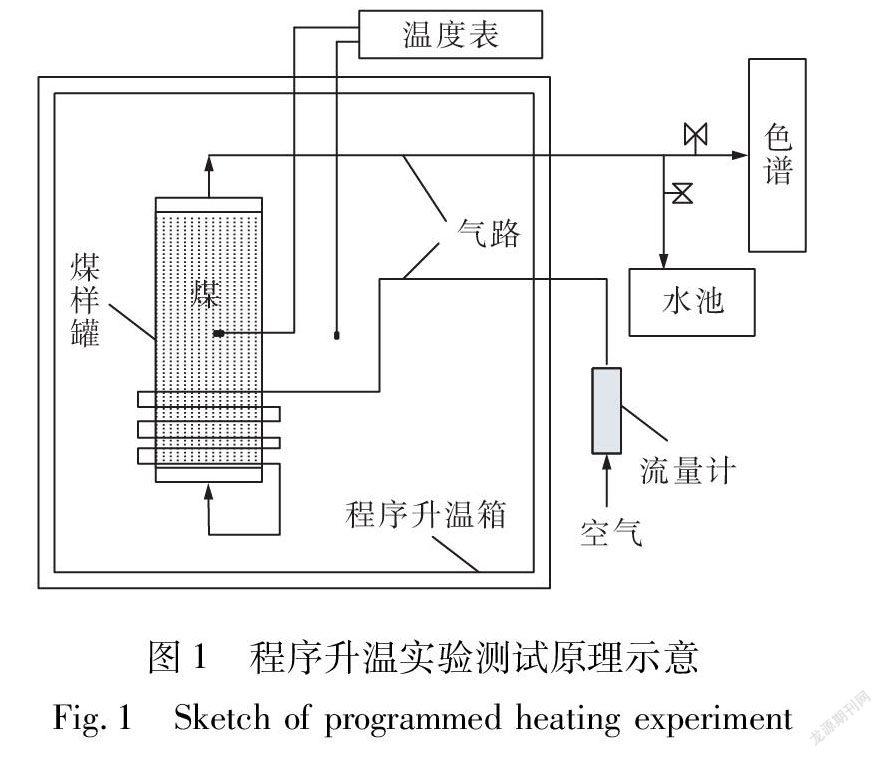
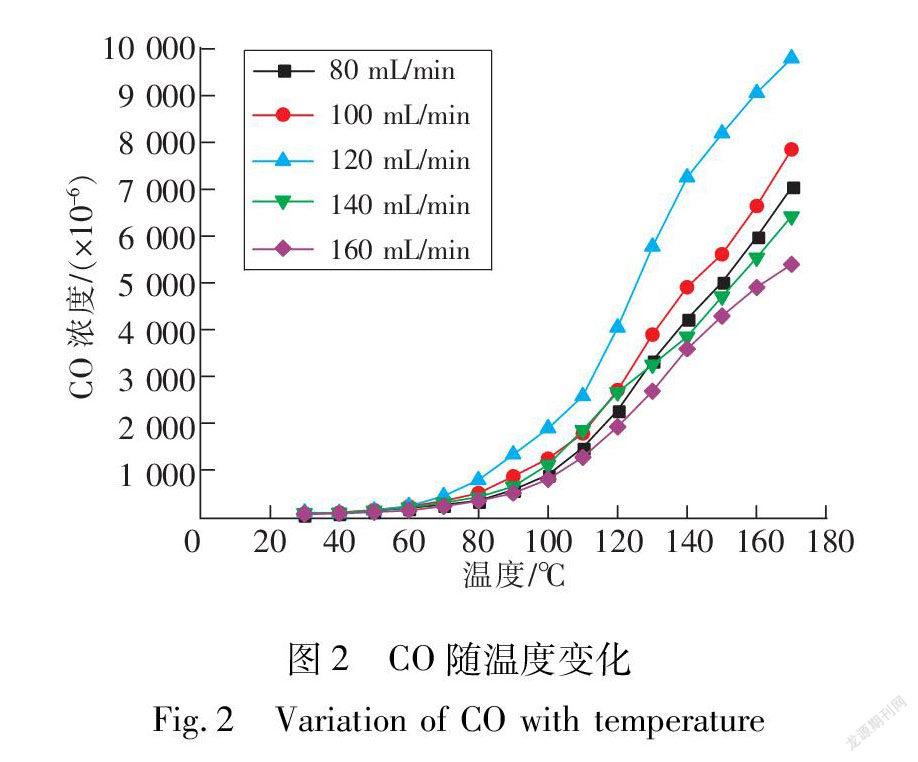
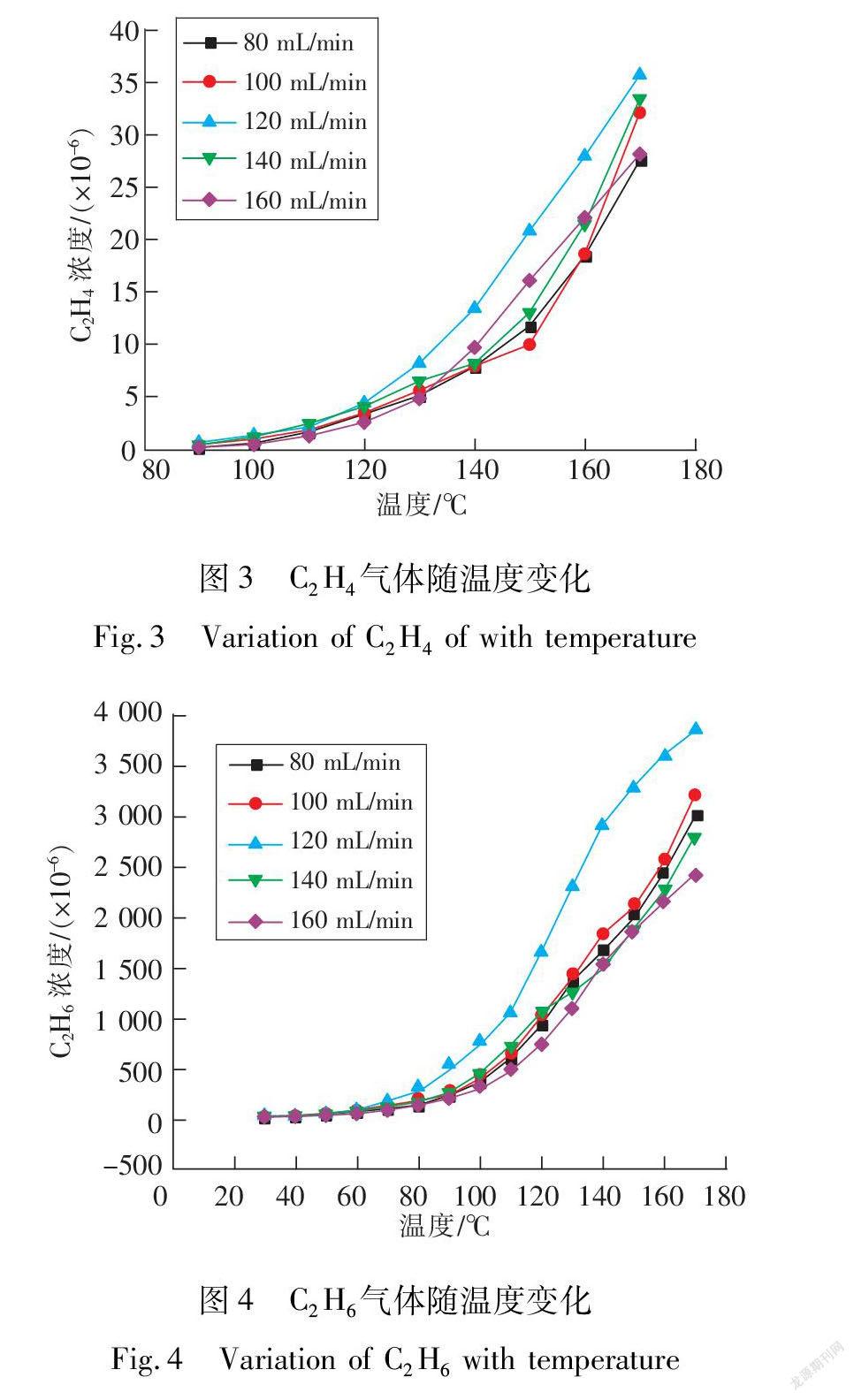
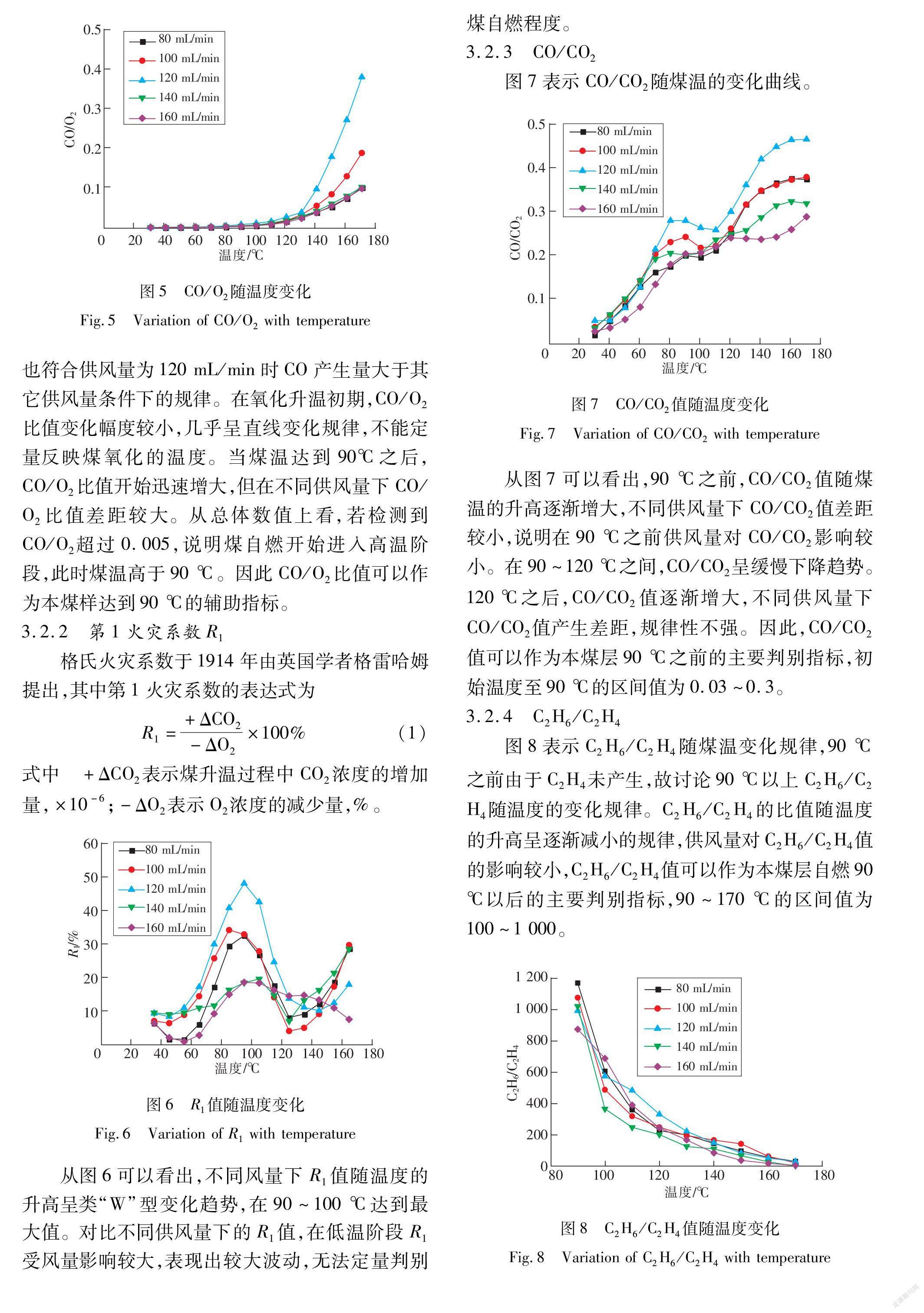
摘 要:为研究供风量对煤自燃指标气体的影响,建立煤自燃定量预测预报指标体系,以潞宁矿区气肥煤为研究对象,利用煤自燃程序升温实验方法,测试了5种供风量下实验煤样在升温过程中的气体产生规律。结果表明:供风量对煤氧化过程CO气体的影响表现出促进和抑制两方面作用,低风量下煤体散热量少但供氧不充分,高风量下煤体供氧充分但蓄热性差,综合表现煤自燃危险性由高到低排序为120,100,80,140,160 mL/min;从供风量对煤自燃气体产生影响与指标值区间单调性角度,定量确定了潞宁矿区气肥煤自燃不同阶段的预测预报指标值,即低温阶段(90℃以下)以CO/CO2值为指标,区间判定指标值为(0.03,0.3),90 ℃时以C2H4出现为指标,高温阶段(90~170 ℃)以C2H6/C2H4值为指标,区间判定指标值为(100,1 000);研究结果为煤矿井下不同供风量下煤自燃程度的准确预测预报提供了参考。关键词:煤自然发火;漏风强度;指标气体;程序升温;供氧中图分类号:TD 75.2
文章编号:1672-9315(2022)01-0016-06 文献标志码:A
DOI:10.13800/j.cnki.xakjdxxb.2022.0103开放科学(资源服务)标识码(OSID):
Experimental study on quantitative prediction indexes of
coal spontaneous combustion based on air supply
WANG Kai1,2,HAN Tao1,2,HE Yunzhong1,2
(1.College of Safety Science and Engineering,Xi’an University of Science and Technology,Xi’an 710054,China;
2.Shaanxi Key Laboratory of Prevention and Control of Coal Fire,Xi’an University of Science and Technology,Xi’an 710054,China)
Abstract:In order to study the influence of air supply on index gas and a quantitative prediction index system of coal spontaneous combustion,a gas fertilized coal in Luning mining area was selected,and gas production rules of coal oxidation under five kinds of air supply were tested by using programmed heating experiment.The results showed that the influence of air supply on CO gas release in coal oxidation process was both promoted and inhibited.Under low air flow,it’s good to store heat but supply oxygen insufficiently,and under high air flow,it’s sufficient to supply oxygen but store heat poorly.In this paper,coal spontaneous combustility was ranked from high to low order of 120 mL/min,100 mL/min,80 mL/min,140 mL/min,160 mL/min.From the perspective of influence of air supply and monotonicity of index value interval,the index system for prediction and prediction of spontaneous combustion of gas fertilizer coal in luning mining area is quantitatively determined,that is,CO/CO2is taken as the index below 90 ℃,which is(0.03,0.3);C2H4 is taken as the index at 90 ℃,and C2H6/C2H4 is taken as the index from 90 ℃ to 170 ℃,which is(100,1 000).The results provide a reference for the accurate prediction of coal spontaneous combustion under different air supply in underground coal mine.Key words:coal spontaneous combustion;air leakage intensity;index gas;programmed heating;oxygen supply
0 引 言
煤自燃是煤炭開采与利用过程中面临的主要灾害之一,产生的有毒有害气体威胁着作业人员的生命安全,甚至可能引起火灾、爆炸等重特大事故,制约煤炭行业的健康发展[1]。前期研究表明,煤的氧化自燃是一个非常复杂的物理化学过程,在这个过程中气体产物会随温度的变化表现出一定的规律性[2]。因此,通过建立煤自燃过程气体产物与煤温之间的对应关系,能够有效利用气体成分预测煤自然发火的程度[3-5]。目前,用于预测煤自燃程度的气体指标可分为单一气体指标与复合气体指标。其中单一气体指标如CO,C2H4等;复合气体指标如CO/ΔO2、格雷哈姆系数、C2H4/C2H6等[6-9]。王德明等利用程序升温实验确定了表征煤自燃程度的临界温度,通过对3种不同变质程度的煤样进行测试,发现程序升温与绝热氧化方法的测试结果一致[10]。邓军等利用程序升温实验装置,测试分析不同风量下CO绝对产生量的变化规律,发现CO绝对产生量随风量的增加而增多,煤温越高,煤自燃所需当量风量就越大[11]。白刚、周西华等对平庄瑞安煤矿褐煤研究发现,随着供风量的增加,CO2/ΔO2、CO/ΔO2、C2H4与煤温的关联程度高,可作为该矿预测预报的指标气体[12-13]。吕志金等通过对5种不同粒径煤样的低温氧化实验研究发现,CO浓度与煤温、风量的曲线呈指数变化关系[14]。郭文杰、王凯、肖旸等研究了粒径、氧浓度及风量对煤自燃过程的影响,发现粒径介于0.18~0.38 mm,空气流量为100 mL/min时,反应产生的气体最多[15-17]。王念鑫、费金彪等在恒温条件下,分析了不同风量对煤自燃过程释放气体浓度和产生率的影响,得出CO、CO2气体浓度随供风量的减小而增大,CO、CO2气体产生率随风量的增加先升高后降低[18-19]。本研究基于风量对煤自燃指标气体的影响,分析不同供风量下煤氧化过程气体产生与温度的对应关系,确定定量的煤自燃预测预报指标体系。
1 实验煤样选用的煤样采自山西潞宁矿区2号煤层,变质程度为气肥煤,实验前将采集的新鲜煤样在氮气环境下破碎碾磨,筛分选取5种粒径范围煤样(0~0.9,0.9~3,3~5,5~7,7~10 mm),并各取200 g组成混合粒度煤样1 kg用于实验。
2 实验方法
2.1 实验装置实验利用西安科技大学研发的煤自燃程序升温装置,该装置主要由供气装置、控温装置及气体采集与分析装置组成,实验装置如图1所示。
2.2 实验条件开始时,将混合煤样装入煤样罐中,连接好气路,通入压缩空气,空气流量恒定,将程序升温箱升温速率设定为0.3 ℃/min,当煤样温度达到30 ℃时开始测定,每隔10 ℃采集一次气体进行色谱分析,直至煤样温度达到170 ℃,结束本组实验,待程序升温箱冷却,取出煤样。共进行5组样品测试,供风量分别为80,100,120,140,160 mL/min。
3 结果与讨论
3.1 单一气体指标
3.1.1 CO气体作为常用煤自燃指标气体,CO产生量随煤温呈一定的规律性[20-22],文中CO气体与温度对应关系如图2所示。从图2可以看出,5种供风量条件下,实验煤样升温过程中CO浓度均随煤温的升
高不断增加,且前期产生量低,后期产生速率加快。
在5种供风量条件下,实验煤样氧化产生CO浓度从高到低关系为:120,100,80,140,160 mL/min。结果表明,供风量与CO产生量不成正比,当供风量为160 mL/min时,虽然提供了大量的氧气,但也带走了更多热量,同时供风量增加也相对降低了CO在产物中的占比。而供风量为80 mL/min时,煤氧化产生的热量散失少,但提供的氧气相对不足,煤氧反应不充分,CO产生量较低。供风量为120 mL/min时,为煤氧化自燃提供了一个较好的供氧和蓄热条件,煤氧化反应较为充分,CO产生速率较快。因此,供风量对煤氧化过程CO浓度有一定的影响,单一CO气体浓度值无法定量预测煤自燃程度。
3.1.2 C2H4与C2H6气体实验中C2H4与C2H6气体与煤温的对应关系如圖3和图4所示。煤温达到90 ℃时,C2H4气体开始出现,煤温越高,C2H4气体产生量越大。C2H4气体浓度与供风量有关,当流量为120 mL/min时,氧化反应过程释放C2H4的浓度最高。C2H6气体在常温下可以检测到,这表明实验煤样中赋存有C2H6气体,在低温阶段C2H6气体的产生与脱附有关,煤样在120 mL/min时氧化程度高于其他风量条件,煤样脱附量大,同时提前进入裂解温度产生C2H6。因此,C2H4气体的出现可以作为煤体达到90 ℃的重要判识指标,而C2H6并不能作为指标气体。
3.2 复合气体指标矿井实际开采条件下,供风量的改变会对单一气体产生较大的影响,因此,通常采用气体的比值(如CO/O2,CO/CO2等)作为判定煤自燃程度的复合指标[23-25]。
3.2.1 CO/O2图5是CO/O2随煤温的变化曲线,在煤温达到90 ℃之前,CO气体产生量较小且氧气消耗少,CO/O2值偏低,100 ℃之后煤样的氧化反应加快,CO/O2值随煤温的升高逐渐增大。
该数值发生突变的阶段与CO指标是一致的,也符合供风量为120 mL/min时CO产生量大于其它供风量条件下的规律。在氧化升温初期,CO/O2比值变化幅度较小,几乎呈直线变化规律,不能定量反映煤氧化的温度。当煤温达到90℃之后,CO/O2比值开始迅速增大,但在不同供风量下CO/O2比值差距较大。从总体数值上看,若检测到CO/O2超过0.005,说明煤自燃开始进入高温阶段,此时煤温高于90 ℃。因此CO/O2比值可以作为本煤样达到90 ℃的辅助指标。
3.2.2 第1火灾系数R1格氏火灾系数于1914年由英国学者格雷哈姆提出,其中第1火灾系数的表达式为
R1=
+ΔCO2-ΔO2×100%
(1)式中 +ΔCO2表示煤升温过程中CO2浓度的增加量,×10-6;-ΔO2表示O2浓度的减少量,%。
图6 R1值随温度变化
Fig.6 Variation of R1 with temperature
从图6可以看出,不同风量下R1值随温度的升高呈类“W”型变化趋势,在90~100 ℃达到最大值。对比不同供风量下的R1值,在低温阶段R1受风量影响较大,表现出较大波动,无法定量判别煤自燃程度。
3.2.3 CO/CO2
从图7可以看出,90 ℃之前,CO/CO2值随煤温的升高逐渐增大,不同供风量下CO/CO2值差距较小,说明在90 ℃之前供风量对CO/CO2影响较小。在90~120 ℃之间,CO/CO2呈缓慢下降趋势。120 ℃之后,CO/CO2值逐渐增大,不同供风量下CO/CO2值产生差距,规律性不强。因此,CO/CO2值可以作为本煤层90 ℃之前的主要判别指标,初始温度至90 ℃的区间值为0.03~0.3。
3.2.4 C2H6/C2H4图8表示C2H6/C2H4随煤温变化规律,90 ℃之前由于C2H4未产生,故讨论90 ℃以上C2H6/C2H4随温度的变化规律。C2H6/C2H4的比值随温度的升高呈逐渐减小的规律,供风量对C2H6/C2H4值的影响较小,C2H6/C2H4值可以作为本煤层自燃90 ℃以后的主要判别指标,90~170 ℃的区间值为100~1 000。
图8 C2H6/C2H4值随温度变化
Fig.8 Variation of C2H6/C2H4 with temperature
4 结 论
1)供风量引起供氧与散热双重作用,宏观表现为煤自燃的促进和抑制效应,本研究中供风量影响CO气体产生浓度的排序由高到低为120,100,80,140,160 mL/min。
2)确定了潞宁矿区气肥煤自燃定量预测预报指标体系,即90 ℃以下以CO/CO2值(0.03~0.3)为指标、90 ℃时以C2H4出现为指标、90~170 ℃以C2H6/C2H4值(100~1 000)为指标。
3)供风量的改变显著影响煤自燃气体的产生量,使得单一气体指标不适用于定量判别煤自燃程度,通过改变供风量发现相对稳定的复合气体指标,可以作为确定煤自燃综合预测预报指标的有效方法。
参考文献(References):
[1] 邓军,李贝,王凯,等.我国煤火灾害防治技术研究现状及展望[J].煤炭科学技术,2016,44(10):1-7,101.
DENG Jun,LI Bei,WANG Kai,et al.Research status and outlook on prevention and control technology of coal fire disaster in China[J].Coal Science and Technology,2016,44(10):1-7,101.[2]
肖旸,李树刚,李明,等.煤自燃预测预报技术研究进展[J].陕西煤炭,2010,29(6):4-7.
XIAO Yang,LI Shugang,LI Ming,et al.Advancement of prediction and forecast technology of coal spontaneous combustion[J].Shaanxi Coal,2010,29(6):4-7.[3]
GUO J,WEN H,ZHENG X Z,et al.A method for evaluating the spontaneous combustion of coal by monitoring various gases[J].Process Safety and Environmental Protection,2019,126:223-231.[4]
WANG K,DENG J,ZHANG Y N,et al.Kinetics and mechanisms of coal oxidation mass gain phenomenon by TG-FTIR and in situ IR analysis[J].Journal of Thermal Analysis and Calorimetry,2018,132(1):591-598.[5]
王凯,姚纪凯,翟小伟,等.煤自燃阶段性预测预报临界指标实验研究[J].煤炭技术,2018,37(6):165-167.
WANG Kai,YAO Jikai,ZHAI Xiaowei,et al.Investigation on prediction critical indexes of stages of coal spontaneous combustion[J].Coal Technology,2018,37(6):165-167.[6]
邓軍,李贝,李珍宝,等.预报煤自燃的气体指标优选试验研究[J].煤炭科学技术,2014,42(1):55-59,79.
DENG Jun,LI Bei,LI Zhenbao,et al.Experiment study on gas indexes optimization for coal spontaneous combustion prediction[J].Coal Science and Technology,2014,42(1):55-59,79.[7]
邓军,杨戍.双鸭山集贤煤矿煤样自燃性程序升温实验研究[J].西安科技大学学报,2005,25(4):411-414.
DENG Jun,YANG Shu.Determination of coal sample spontaneous combustion tendency for Shuangyashan Jixian mine[J].Journal of Xi’an University of Science and Technology,2005,25(4):411-414.[8]
QI X Y,WANG D M,JAMES A M,et al.Self-reaction of initial active groups in coal[J].International Journal of Mining Science and Technology,2012,22(2):169-175.[9]
金永飞,赵瑞元,邓军,等.煤自燃多参数预报指标试验研究[J].煤炭科学技术,2014,42(9):112-114,76.
JIN Yongfei,ZHAO Ruiyuan,DENG Jun,et al.Experiment study on multi parameters prediction indexes of coal spontaneous combustion[J].Coal Science and Technology,2014,42(9):112-114,76.[10]
仲晓星,王德明,尹晓丹.基于程序升温的煤自燃临界温度测试方法[J].煤炭学报,2010,35(S1):128-131.
ZHONG Xiaoxing,WANG Deming,YIN Xiaodan.Test method of critical temperature of coal spontaneous combustion based on the temperature programmed experiment[J].Journal of China Coal Society,2010,35(S1):128-131.[11]
邓军,邓寅,张玉涛,等.风量对煤低温氧化中CO产出影响的试验研究[J].煤炭科学技术,2016,44(12):70-74.
DENG Jun,DENG Yin,ZHANG Yutao,et al.Experiment study on airflow affected to generation of CO with low temperature oxidation of coal[J].Coal Science and Technology,2016,44(12):70-74.[12]
白刚,周西华,孙宝铁,等.褐煤燃烧供风量对碳氢化物生成影响研究[J].中国安全科学学报,2016,26(10):59-63.
BAI Gang,ZHOU Xihua,SUN Baotie,et al.Study on influence of air supply amount on hydrocarbon production for lignite combustion[J].China Safety Science Journal,2016,26(10):59-63.[13]
周西华,王成,李昂,等.褐煤燃烧阶段风量对指标气体的影响[J].洁净煤技术,2017,23(5):18-22,27.
ZHOU Xihua,WANG Cheng,LI Ang,et al.Influence of air amount on index gas for lignite combustion[J].Clean Coal Technology,2017,23(5):18-22,27.[14]
吕志金,欧阳辉,秦清河,等.供风量对煤低温氧化特性影响的实验研究[J].煤矿安全,2016,47(11):23-25,29.
LYU Zhijin,OUYANG Hui,QIN Qinghe,et al.Experimental study on influence of air supply amount on coal low temperature oxidation characteristics[J].Safety in Coal Mines,2016,47(11):23-25,29.[15]
郭文杰.煤自燃特性影响因素的试验研究[J].安全与环境学报,2018,18(4):1307-1311.
GUO Wenjie.Experimental test and examination of the influential factors of the coal spontaneous combustion[J].Journal of Safety and Environment,2018,18(4):1307-1311.[16]
DENG J,XIAO Y,LI Q W,et al.Experimental studies of spontaneous combustion and anaerobic cooling of coal[J].Fuel,2015,157:261-269.[17]
王凱,翟小伟,王炜罡,等.氧浓度与风量对煤热物性参数影响的实验研究[J].西安科技大学学报,2018,38(1):31-36.
WANG Kai,ZHAI Xiaowei,WANG Weigang,et al.Influence of oxygen concentration and blowing rate on thermal property of coal[J].Journal of Xi’an University of Science and Technology,2018,38(1):31-36.[18]
王念鑫,蔡周全,罗振敏,等.风量对煤低温氧化气体产物的影响实验[J].煤矿安全,2016,47(11):33-35,40.
WANG Nianxin,CAI Zhouquan,LUO Zhenmin,et al.Influence experiment of air volume on gas product from coal low temperature oxidation[J].Safety in Coal Mines,2016,47(11):33-35,40.[19]
费金彪,文虎.小风量对煤低温氧化产生气体的影响研究[J].煤矿安全,2017,48(10):21-23,27.
FEI Jinbiao,WEN Hu.Study on the effect of small airflow on gas production of low temperature oxidation of coal[J].Safety in Coal Mines,2017,48(10):21-23,27.[20]
王继仁,邓汉忠,邓存宝,等.煤自燃生成一氧化碳和水的反应机理研究[J].计算机与应用化学,2008(8):935-940.
WANG Jiren,DENG Hanzhong,DENG Cunbao,et al.Coal spontaneous combustion producing carbon monoxide and water reaction mechanism research[J].Computers and Applied Chemistry,2008(8):935-940.[21]
龚克明,蔡康旭,郑旺胜,等.煤低温氧化阶段指标气体产生规律[J].工业安全与环保,2015,41(9):34-36.
GONG Keming,CAI Kangxu,ZHENG Wangsheng,et al.The laws of index gases production during low-temperature oxidation stage of coal[J].Industrial Safety and Environmental Protection,2015,41(9):34-36.[22]
鄧军,赵婧昱,张嬿妮,等.煤样两次程序升温自燃特性对比实验研究[J].西安科技大学学报,2016,36(2):157-162.
DENG Jun,ZHAO Jingyu,ZHANG Yanni,et al.Contrast experimental research on spontaneous combustion of oxidized-coals[J].Journal of Xi’an University of Science and Technology,2016,36(2):157-162.[23]
武福生.预测煤自燃的复合气体指标优选实验研究[J].工矿自动化,2018,44(7):61-65.
WU Fusheng.Experimental study on composite gas indexes optimization for coal spontaneous combustion prediction[J].Industry and Mine Automation,2018,44(7):61-65.[24]
张玉龙,王俊峰,王涌宇,等.环境条件对煤自燃复合指标气体分析的影响[J].中国煤炭,2013,39(9):82-86.
ZHANG Yulong,WANG Junfeng,WANG Yongyu,et al.Effect of experimental conditions on composite index method of gas analysis in spontaneous combustion[J].China Coal,2013,39(9):82-86.[25]
LIANG Y T,ZHANG J,WANG L C,et al.Forecasting spontaneous combustion of coal in underground coal mines by index gases:A review[J].Journal of Loss Prevention in the Process Industries,2019,57:208-222.
2648501186309

